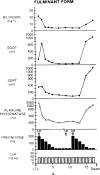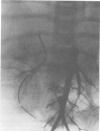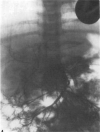Clinical presentation of hepatic artery thrombosis after liver transplantation in the cyclosporine era
- PMID: 3907040
- PMCID: PMC2952489
- DOI: 10.1097/00007890-198512000-00019
Clinical presentation of hepatic artery thrombosis after liver transplantation in the cyclosporine era
Abstract
Hepatic artery thrombosis is a dreadful complication of orthotopic liver transplantation. It should be suspected in cases of fulminant liver failure, delayed bile leak, or intermittent sepsis of unknown cause after liver transplantation. Accurate diagnosis is assisted by ultrasound and computerized tomography scans, but usually requires arteriography. Prompt retransplantation is required in most of the cases.
Figures





References
Publication types
MeSH terms
Substances
Grants and funding
LinkOut - more resources
Full Text Sources
Medical
